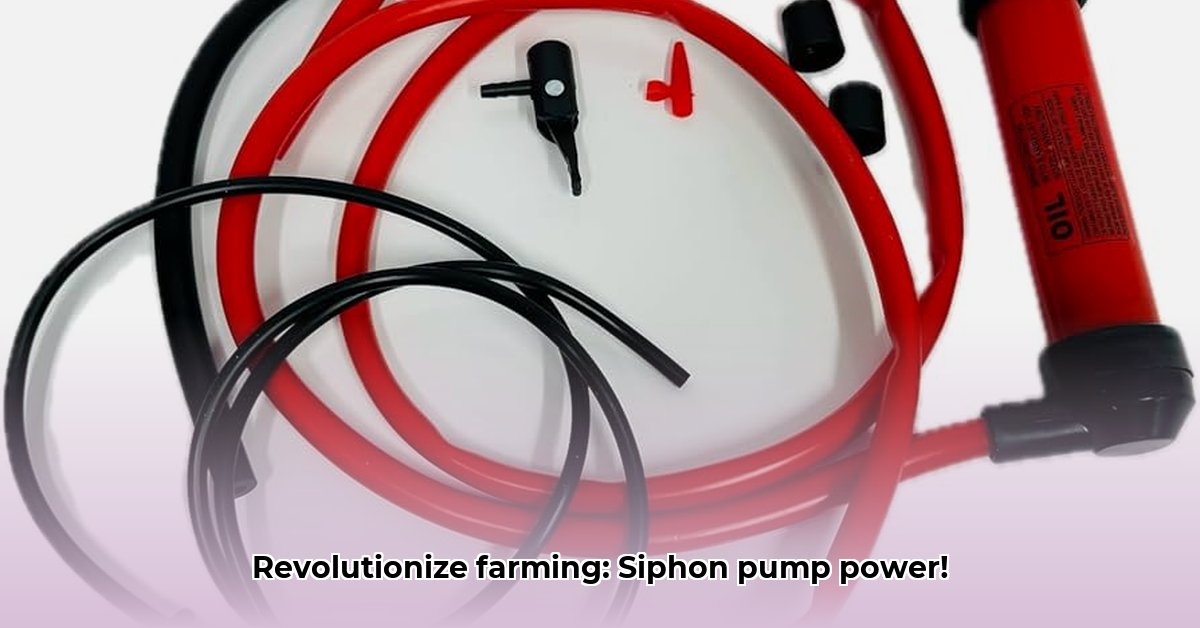
Siphon pumps offer a surprisingly effective and sustainable solution for various liquid transfer tasks on farms, from irrigation to fuel management. This guide provides practical, actionable advice on selecting, using, and maintaining siphon pumps, empowering you to make informed decisions about their role in your farming practices. For more on farm equipment, check out Tractor Supply resources.
How Siphon Pumps Work: Harnessing Gravity and Pressure
Siphon pumps utilize a simple yet elegant principle: they leverage gravity and atmospheric pressure to move liquids from a higher elevation to a lower one. Imagine a straw—you create a vacuum by sucking, allowing the liquid to rise. Siphon pumps operate similarly, creating an initial vacuum that’s then overcome by atmospheric pressure, driving the liquid through the tube. This requires no electricity or fuel, making them an environmentally friendly option.
Selecting the Right Siphon Pump for Your Needs
Choosing the right siphon pump depends on several key factors. The type of liquid to be transferred is crucial: water flows easily, while thicker liquids, like molasses or fuel, require differently designed pumps. The volume of liquid to be moved also impacts the pump selection. Larger diameter tubing moves liquid faster but may be more cumbersome to handle. Finally, consider the distance the liquid needs to travel; longer distances may require more robust pumps. Consult with your local Tractor Supply store expert for personalized advice. They can help you match your needs with the appropriate pump size and model.
Practical Applications in Sustainable Agriculture
Siphon pumps are remarkably versatile tools for sustainable farming. Here are some key applications:
Irrigation: Siphon pumps excel at transferring water from a source (pond, tank) to smaller irrigation systems, reducing reliance on energy-intensive methods. This is particularly useful for supplemental watering of small plots or localized areas.
Livestock Watering: Keeping livestock hydrated efficiently is essential for animal welfare and productivity. Siphon pumps allow the easy transfer of water from a central source to troughs, especially beneficial in areas where animals graze far from natural water bodies. Always maintain clean and safe water sources for animal consumption.
Fuel Transfer: Handling fuel safely and efficiently is critical on a farm. Siphon pumps offer a controlled and safe method for transferring fuel between storage tanks and machinery. Exercise extreme caution. Always handle fuel in well-ventilated areas, away from any open flames or ignition sources. Use appropriate safety equipment, including gloves and eye protection.
Chemical Transfer (with extreme caution): While possible, using siphon pumps for chemical transfer must be approached with the utmost caution. Only use them for non-hazardous chemicals, and always comply with all safety regulations. If any doubt exists, use alternative transfer methods. Using the wrong pump for specific chemicals could damage the pump and corrode it.
Maintaining and Troubleshooting Your Siphon Pump
Routine maintenance is essential for ensuring your siphon pump's longevity and efficient operation. After each use, thoroughly clean the pump and tubing to remove any residue that may clog the system. Regularly inspect the tubing for cracks, kinks or leaks, promptly replacing any damaged sections. If the pump fails to operate, first check for blockages or kinks within the tubing. Make sure the outlet of the tube is consistently lower than the liquid source to maintain gravity flow.
Comparison with Alternative Fluid Transfer Methods
While other methods exist for liquid transfer on a farm, siphon pumps offer unique benefits.
| Feature | Siphon Pump | Electric Pump | Gravity System |
|---|---|---|---|
| Cost | Low initial cost | Higher upfront cost | Moderate to high (depending on setup complexity) |
| Energy Use | None; completely manual | Requires electricity | None, relies on elevation differences |
| Maintenance | Minimal | Moderate to High (potential for repairs) | Usually minimal |
| Transfer Rate | Slower, better for smaller volumes | Faster, especially for larger volumes | Slowest, entirely dependent on gravity and elevation |
| Suitability | Smaller-scale tasks, non-viscous liquids | Versatile, handles various liquids and volumes | Situations with significant elevation differences |
Given these variables, "What are the most cost-effective options for transferring smaller volumes of water on my farm?"
Prioritizing Safety: Essential Precautions
Safe operation is paramount when using siphon pumps. Always wear appropriate personal protective equipment (PPE), such as gloves and eye protection, especially when handling fuels or chemicals. Never leave a running siphon pump unattended. Before each use, carefully inspect the pump and tubing for any damage. Slow, controlled operations and steady siphoning minimize the risk of spills.
Conclusion: Empowering Sustainable Farming Practices
Siphon pumps provide a simple, cost-effective, and environmentally friendly solution for various liquid transfer needs in sustainable agriculture. While they are best suited for smaller-scale operations involving non-viscous liquids, their simplicity and low energy consumption make them a valuable tool when appropriately applied. By understanding their operational principles and safety procedures, you can effectively integrate siphon pumps into your farming practices for increased efficiency and sustainability. However, remember to assess your specific needs and choose the most efficient pump for your farm. Choose wisely!